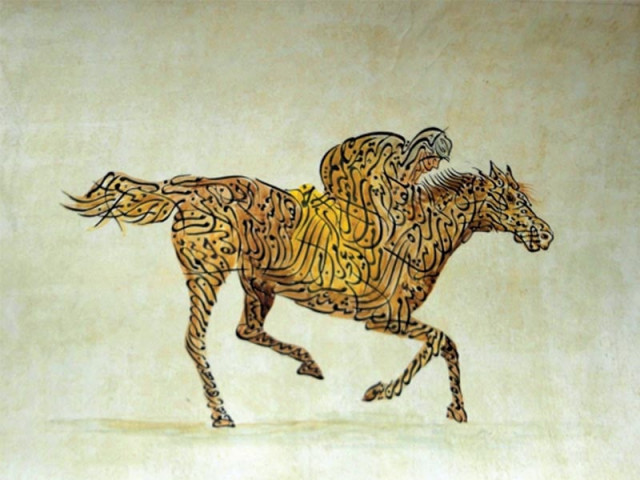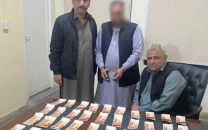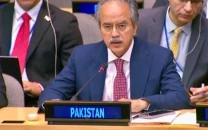Calligraphy exhibition: An artistic tribute to the polymath Omar Khayyam
Inspired by the poet while also highlighting his scientific feats.

“There is a trend of looking towards the West for icons, but we forget how many great intellects have sprouted from the East. That’s why I focused on Khayyam who is known for his poetry but was a great philosopher, arithmetician and scientist,” said Quraishi.
His previous work focused on the poetry of Rumi, who is arguably still revered more than Khayyam as a poet. Irfan, however, noted though his paintings feature Khayyam’s poetry, he aims to highlight his scientific feats that have been forgotten over time.
The symbol of the horse in motion was present in every painting.
At first glance the paintings seemed dismissively similar, but a closer inspection reveals the artist’s thread of cohesion and story. For instance, the use of the horse in various human endeavours — war, sport, travel and grandeur — reveals poetic human thought and action as the vehicle of progress.
The fanciful horse, the unicorn then becomes the symbol for the infinite and unknown capability of human thought while paying homage to poetry itself, which is the product and process of an elevated spiritual experience.
“There is a dance and rhythm in words, there is a power in them that makes us all react. Understanding the beauty of words is what calligraphy is all about. Khayyam saw the formula in all things, not in a dry sense but a reassuring one, there is after all a golden ratio of human beings also,” said the artist.

The exhibition, in light of Khayyam’s 83rd death anniversary on Tuesday, also featured renditions of the late poet’s Persian and English translated works recited by Osman Qazi.
A mime play directed by Indu Mitha, renowned classical dancer, moved the audience with its sheer simplicity and power. As Mitha narrated, a potter’s tale was revealed who has the ability to make both pristine and distorted artefacts from dirt, signifying the inherent ability in all artists to find beauty in pain and disfigurement.
“There is a story in itself in Indu’s face, there is a dance of expressions and her being lends character to everything she does,” said Kausar Khan, principal of Mazmoon-e-Shauq School.
In true Mitha character, humble and frank, the dancer did not want to shed much light on her work in the play, but then the play spoke for itself with little to no words.

The mime performance also addressed issues such as class divide and poverty: a Brahmin woman is seen shunning an ‘untouchable’ who drinks from her cup.
Then there’s the potter who makes all his creations from the same “mitti” (clay). The clay is transformed once the object takes shape and is in the hands of an individual — the value of the cup is equal to the wealth of the holder. Amidst difference and discrimination, a silver lining is found by Mitha who unifies the pottery and the individuals under the knowledge that we are all made from the same clay.
The exhibition will continue till December 5.
Published in The Express Tribune, December 3rd, 2012.


















COMMENTS
Comments are moderated and generally will be posted if they are on-topic and not abusive.
For more information, please see our Comments FAQ